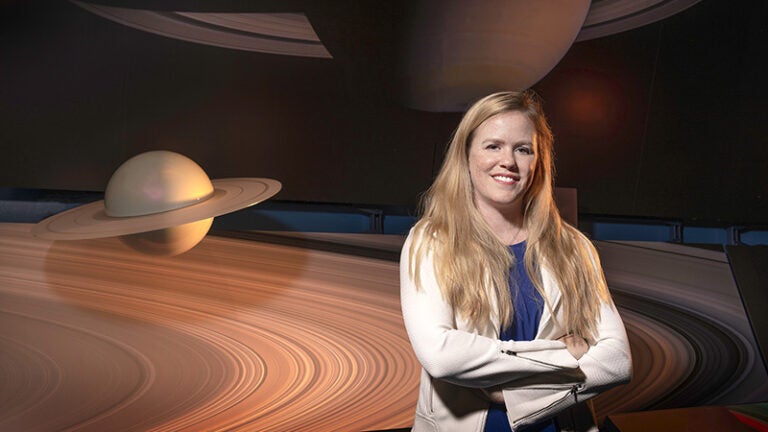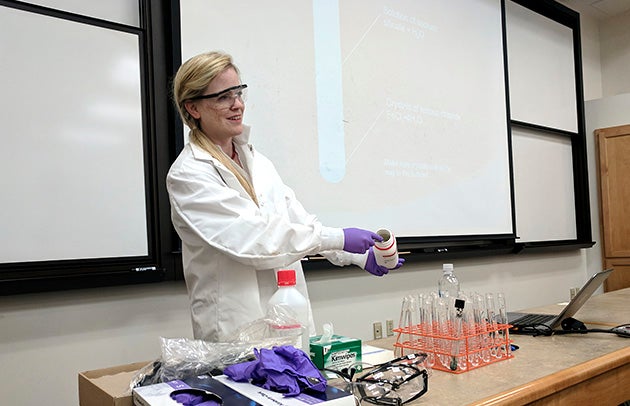
Could alien worlds hold life? One USC Dornsife alumna aims to find out
If you rewound the timeline of Earth to the beginning and then restarted it, would you get life again? What if you rewound it again and again?
If you tweaked some major condition, like taking away the moon or the continents, or if the atmosphere became a whole different composition, would life emerge again? Would it be the same life, or one so strange we’d hardly recognize it as alive?
These are the questions alumna Laurie Barge contemplates in her Origins and Habitability Lab at NASA’s Jet Propulsion Laboratory (JPL) in Pasadena, California, where she routinely plays God, building deep-sea chimney vents, mixing up Martian minerals and pulling the ocean’s energy.
Barge’s experimental sandbox is a bit smaller than God’s — her vents and oceans are contained within jars, tubes and aquariums — but her purpose is still grand. Barge, who received her Ph.D. in geological sciences from the USC Dornsife College of Letters, Arts and Sciences in 2009, is researching how life first sprang up on Earth and which conditions are most essential to its emergence.
To do so, she simulates environments like ocean vents, which some scientists hypothesize played host to the first life forms, and tinkers around with their chemicals and minerals. Through these experiments, and many others, Barge gains insight into what is necessary for life to spring forth here — and on other worlds.
The more we know about the birth of life on our own planet, the better equipped we will be at finding signs of life on alien worlds, says Barge. She hopes to determine if the life that emerged on Earth could also flourish in the icy waters of Jupiter’s or Saturn’s moons or in other, far-flung parts of the galaxy.
“Far above the moon / planet Earth is blue”
Space has been Barge’s obsession since childhood. A Star Trek enthusiast and avid reader of books on planets and the stars, in fifth grade she wrote a report on black holes sucking up super stars, illustrating it with a colored pencil depiction of the event.
With her eyes set on a career with NASA early-on, she enrolled as an undergraduate at Villanova University to pursue a degree in astronomy and astrophysics. Though it was fascinating to learn about cosmology and the life cycle of stars, she also wanted to understand life in the universe, which required more focus on the planets around those stars.
She found herself pulled back to Earth.
“I really wanted to know: ‘Why are we here? Why is there life on Earth at all, and why isn’t it (or is it) elsewhere?’” says Barge.
She began reading scientific papers on the subject of life in the universe and discovered the work of USC Dornsife’s Ken Nealson. Now Professor Emeritus of Earth Sciences, Nealson used geology to search for signs of life on other planets, especially Mars. Soil, rocks and terrain contain a rich array of clues about all that came before. If life exists elsewhere, geology will bear its imprint.
“I did a big report on Venus for a planetary class, and the books I was reading all had words like ‘basalt’ and ‘granite,’ and I didn’t even know why those were important,” says Barge. “That’s when I realized that to really do this type of work, you need to know more about the planets. I needed to learn geology.”
Blueberry fields forever
After graduation from Villanova, Barge headed to USC to earn a Ph.D. in geological sciences. Nealson, the source of Barge’s inspiration to pursue geological sciences, became her Ph.D. advisor.
Her thesis first focused on simulating microbial growth in Martian environments, but that didn’t end up working out. She hunted around for another thesis focus and finally settled on blueberries — of the Martian variety.
Back in 2004, the Mars rover Opportunity discovered strange, crystallized spheres of hematite, an iron oxide, on the surface of Mars. The hematite showed blue on NASA imaging, earning them the nickname “blueberries.” These formations can sometimes signal past water, making them a tantalizing subject for the study of extraterrestrial life on the red planet.
Similar hematite formations can be found on Earth, in Utah’s Navajo Sandstone region, so Barge collaborated with researchers from the University of Utah to conduct geological research in the area. She then attempted to replicate their formation in the lab to learn how the Martian versions might have formed.
Building bridges to STEM

Laurie Barge co-leads a project showing college students the value of a STEM education.
After her own successful entry into the science field, Barge is making sure there’s a new batch of young scientists entering the field, as well. With her colleague Marianne Smith at Citrus College in Glendora, California, she co-leads a National Science Foundation-funded project, Bridge to the Geosciences, that shows Citrus students the wealth of job opportunities that geosciences and other STEM degrees can provide.
Students considering science, technology, engineering and math careers shadow scientists at facilities like JPL and USC Dornsife’s Wrigley Marine Science Center on Santa Catalina Island off the Los Angeles coast, and they can participate in a “mini-internship” at the University Corporation for Atmospheric Research in Colorado.
“It gives them exposure to different careers in the sciences, shows them the diversity of careers that are available. You don’t have to become a professor if you major in science, you can work in nonprofits, industry, education, any number of things,” says Barge.
“There’s life Jim, but not as we know it”
Barge search for life’s origins continues across the seas and skies. She is the science lead for the InVADER mission, which will send a probe down to the deepest depths of the ocean, near the Axial Seamount, a sprawling underwater volcano off the coast of Oregon. In the darkness, vents constantly churn with chemical energy.
Understanding how life forms there could help us make sense of more “ocean worlds” in our solar system, which could have their own deep-sea vents, says Barge.
She’s also the investigation scientist for HiRISE, the most powerful camera ever sent to another planet. HiRISE takes detailed images of Martian geological formations and NASA’s rovers scouting the planet’s terrain.
With the new rover Perseverance now safely landed on the surface of Mars, hunting for signs of ancient life, Barge has a new host of information headed her way to make use of in her lab.
“Mars has a lot of very old surface that dates back to the time period that life began on Earth – so maybe Mars could be a window into early Earth around the time of the origin of life,” says Barge.
More space blueberry investigation, or something similarly alien, could be on the horizon.